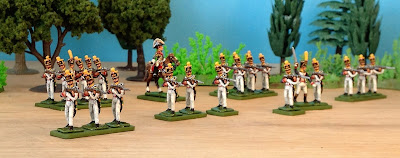My Polish lancers are proceeding, but very very slowly.
I have almost finished their flag, however, so faute de mieux, here it is. It's probably a good idea to show it at this stage in any case as one of the sides will be partially obscured when my lancer is holding it.
The 7th Lancers didn't actually have a flag, so what I've given them is the first squadron guidon of their predecessors, the Lancers of the Polish Legion of the Danube. They didn't become the Vistula Lancers until 1808.
Four squadron guidons were given to the regiment by Napoleon, then first-consul, in 1800. They were also offered an imperial eagle in 1804, but refused, preferring to retain the very attractive and distinctive flags they already had. Then disaster struck. In 1809 all four squadron flags were lost to the Army of La Mancha at Los Yébenes in Spain.
We know what they looked like, however, as two of the flags survive - one in a cathedral in Spain, and the other (the guidon of the 1st Squadron) at the Musée de L'Armée in Paris. Pictures of the guidons and the story of their loss and recovery can be seen in the splendid article by Luis Sorando Muzás on the Napoleon Series website, here.
My flag is made from a very thin sheet of brass wrapped around a steel wire. The brass was donated by my good friend and next-door-neighbour, who has the most amazing talent for finding things. The dimensions are approximately 10mm by 14mm. Although the photo doesn't really show it, the flag pole is blue. I may need to use a lighter shade in the finish.
WM
I have almost finished their flag, however, so faute de mieux, here it is. It's probably a good idea to show it at this stage in any case as one of the sides will be partially obscured when my lancer is holding it.
The 7th Lancers didn't actually have a flag, so what I've given them is the first squadron guidon of their predecessors, the Lancers of the Polish Legion of the Danube. They didn't become the Vistula Lancers until 1808.
Four squadron guidons were given to the regiment by Napoleon, then first-consul, in 1800. They were also offered an imperial eagle in 1804, but refused, preferring to retain the very attractive and distinctive flags they already had. Then disaster struck. In 1809 all four squadron flags were lost to the Army of La Mancha at Los Yébenes in Spain.
We know what they looked like, however, as two of the flags survive - one in a cathedral in Spain, and the other (the guidon of the 1st Squadron) at the Musée de L'Armée in Paris. Pictures of the guidons and the story of their loss and recovery can be seen in the splendid article by Luis Sorando Muzás on the Napoleon Series website, here.
My flag is made from a very thin sheet of brass wrapped around a steel wire. The brass was donated by my good friend and next-door-neighbour, who has the most amazing talent for finding things. The dimensions are approximately 10mm by 14mm. Although the photo doesn't really show it, the flag pole is blue. I may need to use a lighter shade in the finish.
WM






